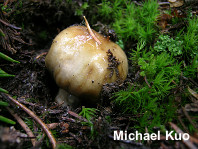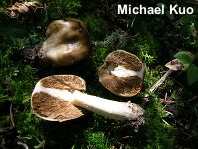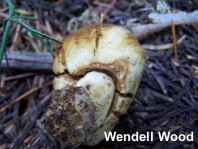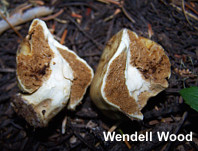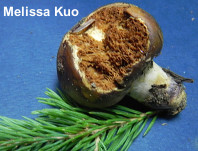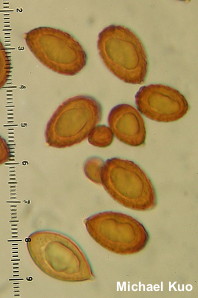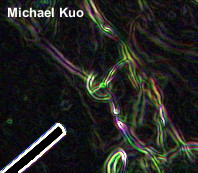| Major Groups > Oddballs & Misfits > Gasteroid Gilled Mushrooms & Boletes > Cortinarius pinguis |
| Major Groups > Gilled Mushrooms > Dark-Spored > Cortinarius > Cortinarius pinguis |

|
Cortinarius pinguis [Basidiomycota > Agaricales > Cortinariaceae > Cortinarius ... ] by Michael Kuo Formerly known as Thaxterogaster pingue, this oddball of the western mountains is actually a "gasteroid" species of Cortinarius. Its cap begins to develop but never opens up to expose the gills, which are consequently poorly formed. The microscopic spore-producing machinery works perfectly well, however, manufacturing Cortinarius-like spores that are presumably dispersed when the cap begins to disintegrate, or when foraging creatures have a yummy meal and continue foraging elsewhere. Mycologists have long debated the evolutionary significance of gasteroid gilled mushrooms and boletes like Cortinarius pinguis, and have often been tempted to see these mushrooms as "transitional" forms. But recent DNA analyses have begun to place some gasteroid genera like Thaxterogaster smack in the middle of "normal" genera—indicating the likelihood that gastroid forms evolved independently as adaptations to certain environments. Cortinarius pinguis appears to be closely related to Cortinarius collinitus and similar species in subgenus Myxacium (see Peintner and collaborators, 2004). Cortinarius pinguis is a common late summer and fall find under conifers in the Rocky Mountains, and it also occurs in the Cascades and the Sierra Nevada. It has an olive brown, sticky cap, and a whitish cortina. It usually features a fairly well-developed stem, but when it grows underground or partially submerged the stem may be rudimentary or nearly absent. The interior of the cap, when sliced open, features a mass of poorly formed, reddish brown gills. Cortinarius pavelekii (née Thaxterogaster pavelekii; see Trappe & Castellano, 2000) is a similar but rare species known from the West Coast, best separated with microscopic analysis; it lacks clamp connections. Cortinarius pingue is an alternate spelling. Thanks to Wendell Wood for collecting, documenting, and preserving some of the illustrated and described specimens; his collection is deposited in The Herbarium of Michael Kuo. Description: Ecology: Mycorrhizal with conifers, especially firs and Engelmann spruce; growing scattered or gregariously, often partially submerged in needle duff; summer and fall; common in the Rocky Mountains but occasionally reported from the Sierra Nevada and the Cascades (under firs). The illustrated and described collections are from Colorado and Oregon. Cap: 1–3 cm; convex or irregularly blockish; sticky or slimy; broadly wrinkled or more or less smooth; bald; olive brown or brownish yellow; the margin fused to the stem with whitish, cortina-like material; never opening to expose the interior. Interior: Reddish brown; a mass of poorly formed "gills" and occasional air pockets. Stem: Sometimes absent or rudimentary (especially in drier regions, where Cortinarius pinguis grows partially submerged or nearly underground); 2–4 cm long; 0.5-1 cm thick; more or less equal; dry; whitish or pale brownish, but often with pinkish or lilac flushes near the base. Flesh: Whitish; unchanging when sliced; forming a central column through the interior of the cap. Odor: Strong and sweet, reminiscent of the foetid russulas. Microscopic Features: Spores 14–18 x 8–12 µm; ellipsoid; moderately verrucose; orangish brown in KOH; dextrinoid. Clamp connections present in hymenium and in columella trama. REFERENCES: (Zeller, 1941) Peintner, Moser & Vilgalys, 2002. (Smith, Smith & Weber, 1981; Arora, 1986; Phillips, 1991/2005; Evenson, 1997; Peintner, Moncalvo & Vilgalys, 2004; Trappe, Evans & Trappe, 2007.) Herb. Kuo 09010604, 09261205. Herb. DBG RMNP 2008-034, ROMO 2012 5023-20, ROMO 2012 5025-01. This site contains no information about the edibility or toxicity of mushrooms. |
© MushroomExpert.Com |
|
Cite this page as: Kuo, M. (2016, September). Cortinarius pinguis. Retrieved from the MushroomExpert.Com Web site: http://www.mushroomexpert.com/cortinarius_pinguis.html |
